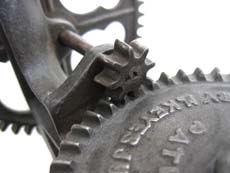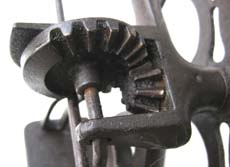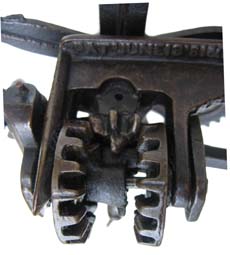|












|
Bevel
Gears
 Bevel
gears have a slight conical shape and are used in apple parers
to change the direction of motion. The small table gears and the
turntable
gears as illustrated by the Keyes (to the right) that rotate paring
arms are good examples. The slight conical shape of bevel gears
allows
them
to
work only on
axles
positioned
at angles greater than 0 or less
than 180-degrees. Bevel
gears have a slight conical shape and are used in apple parers
to change the direction of motion. The small table gears and the
turntable
gears as illustrated by the Keyes (to the right) that rotate paring
arms are good examples. The slight conical shape of bevel gears
allows
them
to
work only on
axles
positioned
at angles greater than 0 or less
than 180-degrees.
 The
J.J. Parker (pictured to the left) uses a bevel gear to rotate the paring
arm 180-degrees. The S.S. Hersey (below) may have the most interesting
bevel gear
system. A small
bevel
gear sits
between two larger bevel gears at a 90-degree angle. The two larger bevel
gears rest on the same axle as the paring arm. On this axle, between
the two larger bevel gears, rests a smaller modified gear connected to
the paring arm. The paring arms modified gear has only two teeth, each
pointed
to the opposite bevel gear. The size of this centrally located gear with
two teeth allows it to only engage one of the larger bevel gears at a
time. The
J.J. Parker (pictured to the left) uses a bevel gear to rotate the paring
arm 180-degrees. The S.S. Hersey (below) may have the most interesting
bevel gear
system. A small
bevel
gear sits
between two larger bevel gears at a 90-degree angle. The two larger bevel
gears rest on the same axle as the paring arm. On this axle, between
the two larger bevel gears, rests a smaller modified gear connected to
the paring arm. The paring arms modified gear has only two teeth, each
pointed
to the opposite bevel gear. The size of this centrally located gear with
two teeth allows it to only engage one of the larger bevel gears at a
time.
 As
one cranks the hand-driven gear the small bevel gear rotates the two
larger bevel gears in opposite directions. The paring arm follows the
direction of the large bevel gear that is engaged with its modified gear.
Once the paring action is completed a lever on the small bevel gear pushes
the paring arm’s modified gear across its axle to engage the opposite
bevel gear. After the gear switch, an apple can be pared in the reverse
direction. As
one cranks the hand-driven gear the small bevel gear rotates the two
larger bevel gears in opposite directions. The paring arm follows the
direction of the large bevel gear that is engaged with its modified gear.
Once the paring action is completed a lever on the small bevel gear pushes
the paring arm’s modified gear across its axle to engage the opposite
bevel gear. After the gear switch, an apple can be pared in the reverse
direction.
Visit Industrial Quick Search for a comprehensive article on bevel gears.
|

